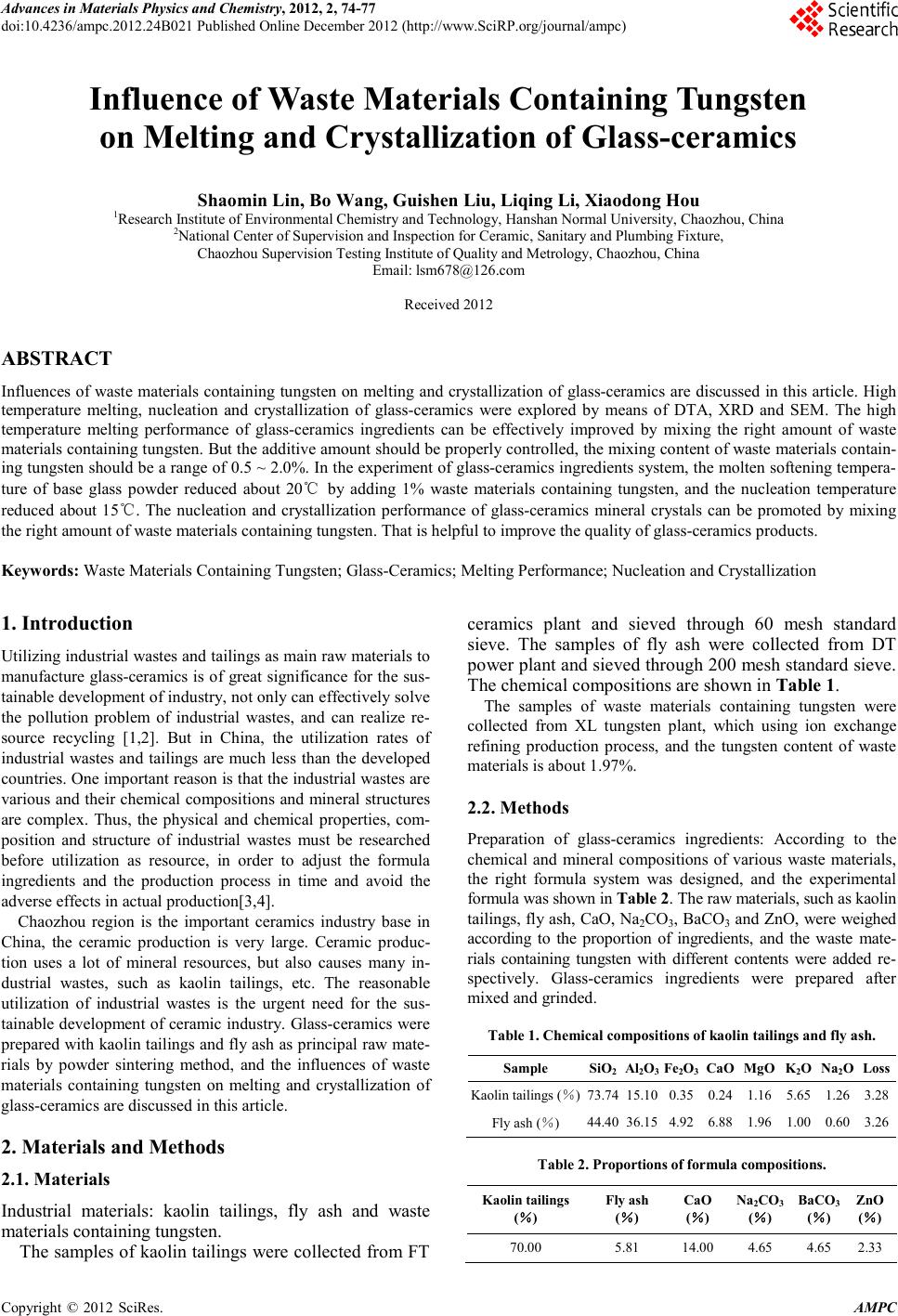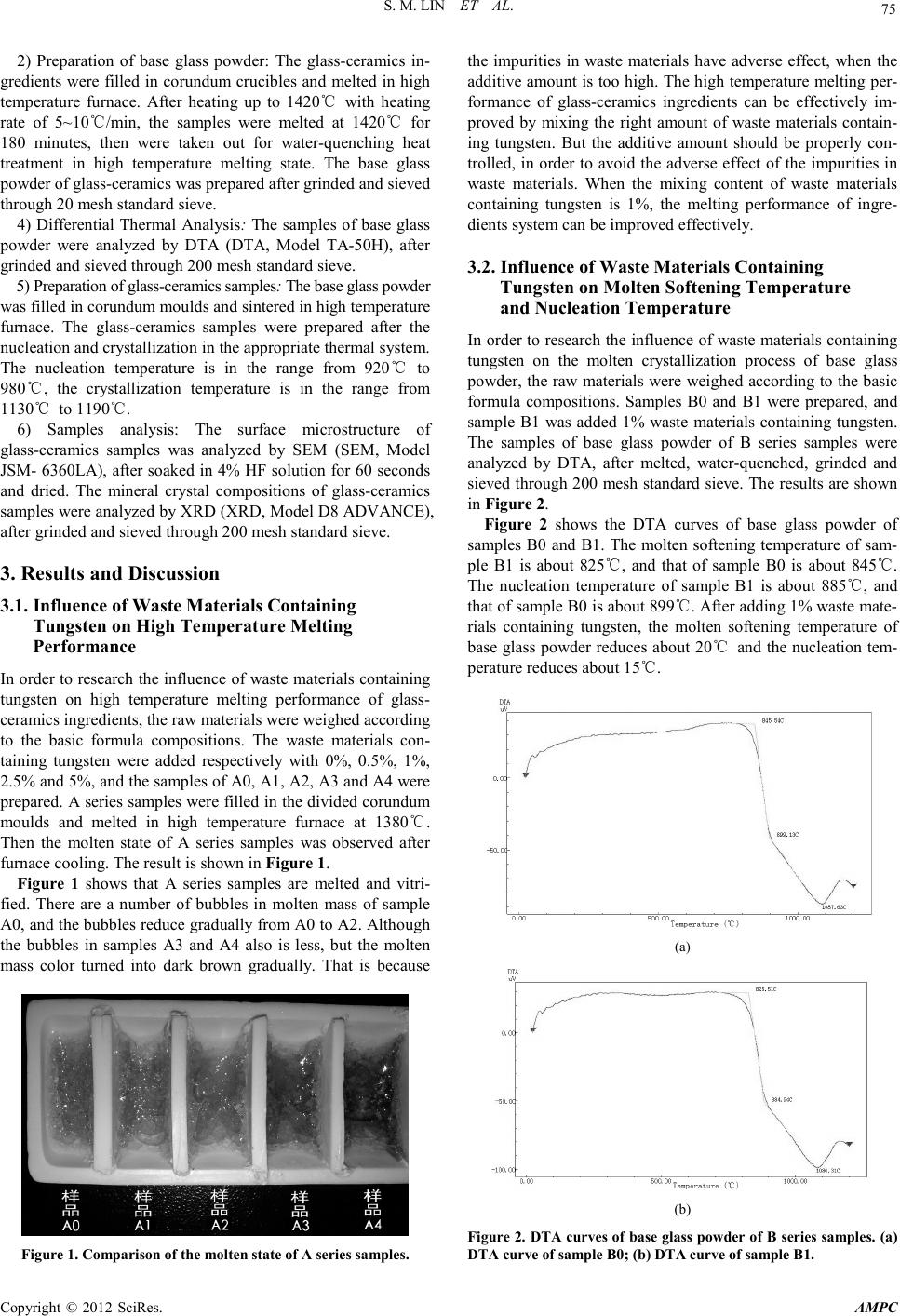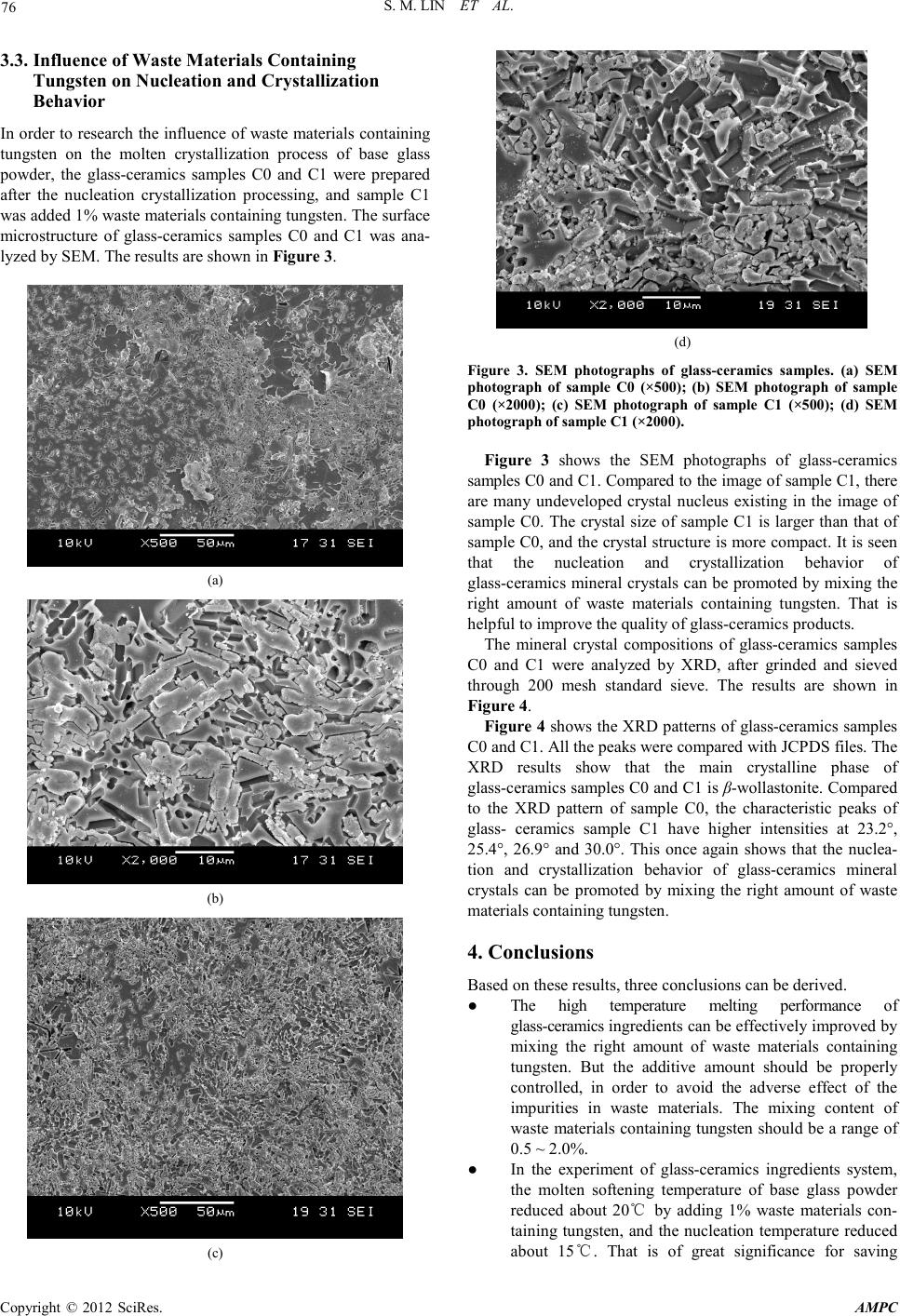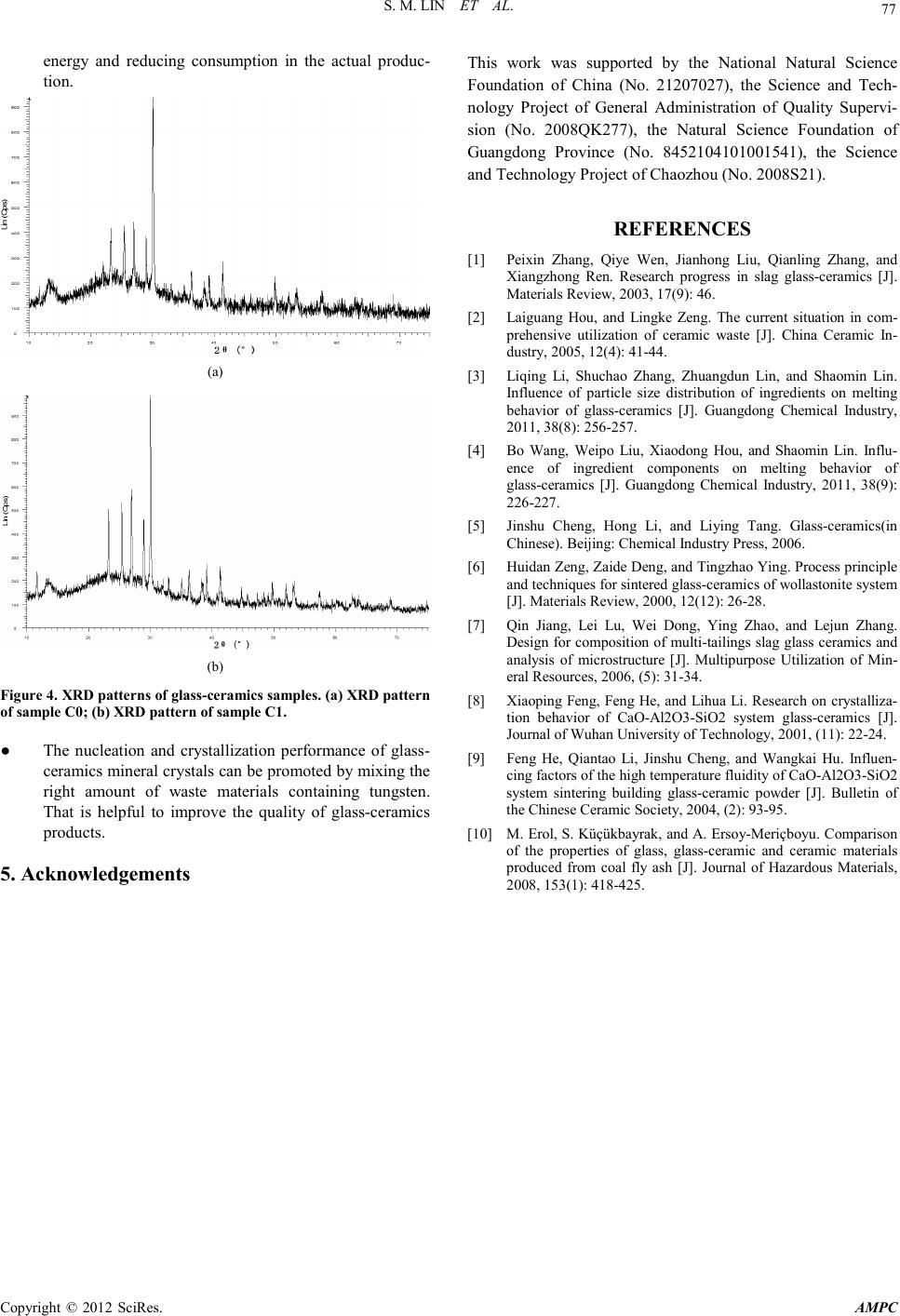Paper Menu >>
Journal Menu >>
 Advan ces in Materials Physics and Che mist ry, 2012, 2, 74-77 doi:10.4236/ampc.2012.24B021 Published Online December 2012 (http://www.SciRP.org/journal/ampc) Copyright © 2012 SciRes. AMPC Influence of Waste Materials Containing Tungsten on Melting and Crystallization of Glass-ceramics Shao min Lin, Bo Wa ng, Guishen Liu, Liqing Li, Xiaodong Hou 1Research Institute of Environmental Chemistry and Technology, Hanshan Normal University, Chaozhou, China 2National Center of Supervision and Inspection for Ceramic, Sanitary and Plumbing Fixture, Chaozh ou Supervision Testi ng Institut e of Quality and Metrolog y, Chaozhou, China Email: lsm678@126.com Received 2012 ABSTRACT Influen ces of wast e materials containing tungsten on melting and crystallization of glass-ceramics are d iscussed in this article. High temperature melting, nucleation and crystallization of glass-ceramics were explored by means of DTA, XRD and SEM. The high temperature melting performance of glass-ceramics ingredients can be effectively improved by mixing the right amount of waste materials containing tungsten. But the additive amount should be properly controlled, the mixing content of waste materials contain- ing tungsten should be a range of 0.5 ~ 2.0%. In the experiment of glass-ceramics ingredients system, the molten softening tempera- ture of base glass powder reduced about 20℃ by adding 1% waste materials containing tungsten, and the nucleation temperature reduced about 15℃. The nucleation and crystallization performance of glass-ceramics mineral crystals can be promoted by mixing the right amount of waste materials containing tungsten. That is helpful to improve the quality of glass-ceramics products. Keywords: Waste Materials C ontaining Tungsten; Glass-Ceramics; Melting Perfo r mance; N ucleation and Cr ystall ization 1. Introduction Utilizing industrial wastes and tailings as main raw materials to manufacture glass-cer amics is of great significance for t he sus- tainable development of industry, not only can effectively solve the pollution problem of industrial wastes, and can realize re- source recycling [1,2]. But in China, the utilization rates of industrial wastes and tailings are much less than the developed countries. One important reason is that the industrial wastes are various and thei r chemical co mpo sitions and mineral structures are complex. Thus, the physical and chemical properties, com- position and structure of industrial wastes must be researched before utilization as resource, in order to adjust the formula ingredients and the production process in time and avoid the adverse effects in actual pro duction[3, 4] . Chaozhou region is the important ceramics industry base in China, the ceramic production is very large. Ceramic produc- tion uses a lot of mineral resources, but also causes many in- dustrial wastes, such as kaolin tailings, etc. The reasonable utilization of industrial wastes is the urgent need for the sus- tainab le develop ment of ceramic in dustry. Glass-cer amics were prepar ed with kaoli n tailings and fly ash as p rincip al raw mate- rials by powder sintering method, and the influences of waste materials containing tungsten on melting and crystallization of glass-ceramics are discu ss ed in this art icle. 2. Materials and Methods 2.1. Materials Industrial materials: kaolin tailings, fly ash and waste materials containing tungsten. The samples of kaolin tailings were collected from FT ceramics plant and sieved through 60 mesh standard sieve. The samples of fly ash were collected from DT power plant and sieved through 200 mesh standard sieve. The chemical compositions ar e sho wn in Ta b le 1. The samples of waste materials containing tungsten were collected from XL tungsten plant, which using ion exchange refining production process, and the tungsten content of waste materials i s about 1.97%. 2.2. Methods Preparation of glass-ceramics ingredients: According to the chemical and mineral compositions of various waste materials, the right formula system was designed, and the experimental formula was shown in Table 2. The raw materials, such as kaolin tailings, fl y ash, CaO, Na2CO3, BaCO3 and ZnO, were weighed according to the proportion of ingredients, and the waste mate- rials containing tungsten with different contents were added re- spectively. Glass-ceramics ingredients were prepared after mixed and grinded. Tabl e 1. Chemical compos it ion s of kaolin taili ngs and fl y as h . Sample SiO2 Al2O3 Fe2O3 CaO MgO K2O Na2O Loss Kaolin tailings (%) 73.74 15.10 0.35 0.24 1 .1 6 5.65 1 .2 6 3.28 Fly ash (%) 44.40 36.15 4.92 6.88 1.96 1.0 0 0.60 3.26 Tabl e 2. Proportions of formula com positions. Kaolin tailings ( % ) Fly ash ( % ) CaO ( % ) Na2CO3 ( % ) BaCO3 ( % ) ZnO ( % ) 70.00 5.81 14.00 4.65 4.65 2.33  S. M. LIN ET AL. Copyright © 2012 SciRes. AMPC 75 2) Preparation of base glass powder: The glass-ceramics in- gredients were filled in corundum crucibles and melted in high temperature furnace. After heating up to 1420℃ with heating rate of 5~10℃/min, the samples were melted at 1420℃ for 180 minutes, then were taken out for water-quenching heat treatment in high temperature melting state. The base glass powder of glass-ceramics was prep ar ed after grinded and sieved through 20 mesh standard sieve. 4) Differential Thermal Analysis: The samples of base glass powder were analyzed by DTA (DTA, Model TA-50H), after grinded and sieved through 200 mesh standard sieve. 5) Preparation of glass-cerami cs sam pl es : The base gla ss pow der was filled in corundum moulds and sintered in high temperature furnace. The glass-ceramics samples were prepared after the nucleation and crystallization in the appropriate thermal system. The nucleation temperature is in the range from 920℃ to 980℃, the crystallization temperature is in the range from 1130℃ to 11 90℃. 6) Samples analysis: The surface microstructure of glass-ceramics samples was analyzed by SEM (SEM, Model JSM- 6360LA), after soaked in 4% HF solution for 60 seconds and dried. The mineral crystal compositions of glass-ceramics samples were an al yzed by XRD ( XR D, Model D8 ADVANCE), after grinded and sieved through 200 mesh standard sieve. 3. Results and Discussion 3.1. Influence of Waste Materials Containi ng Tungsten on High Temperat ure M e lting Performance In order to resear ch the influence of waste material s containing tungsten on high temperature melting performance of glass- ceramics i ngredients, the raw materials were weighed according to the basic formula compositions. The waste materials con- taining tungsten were added respectively with 0%, 0.5%, 1%, 2.5% and 5 %, and th e samples of A0, A1, A2, A3 and A4 were prepar ed. A series samples were filled in the divided corundum moulds and melted in high temperature furnace at 1380℃. Then the molten state of A series samples was observed after furnace cooling. The result is shown in Figure 1. Figure 1 shows that A series samples are melted and vitri- fied. There are a number of bubbles in molten mass of sample A0, and the bubbles reduce gradually fro m A0 to A2. Although the bubbles in samples A3 and A4 also is less, but the molten mass color turned into dark brown gradually. That is because Figure 1. Comparison of the molten state of A series samples. the impurities in waste materials have adverse effect, when the additive amount is too high. The high temperature melting per- formance of glass-ceramics ingredients can be effectively im- proved by mixing the right amount of waste materials contain- ing tungsten. But the additive amount should be properly con- trolled, in order to avoid the adverse effect of the impurities in waste materials. When the mixing content of waste materials containing tungsten is 1%, the melting performance of ingre- dients system can be impr oved effectively. 3.2. Influence o f Waste M at erials Contai ning Tungsten on Molten Softening Tempera ture and Nuclea tion Temperature In order to resear ch the influence of waste material s containing tungsten on the molten crystallization process of base glass powder, the raw materi als were weigh ed accord ing to t he basic formula compositions. Samples B0 and B1 were prepared, and sample B1 was added 1% waste materials containing tungsten. The samples of base glass powder of B series samples were analyzed by DTA, after melted, water-quenched, grinded and sieved through 200 mesh standard sieve. The results are shown in Figure 2. Figure 2 shows the DTA curves of base glass powder of samples B0 and B1. The molten softening temperature of sam- ple B1 is about 825℃, and that of sample B0 is about 845℃. The nucleation temperature of sample B1 is about 885℃, and that of sample B0 is about 899℃. After adding 1% waste mate- rials containing tungsten, the molten softening temperature of base glass powder reduces about 20℃ and the nucleation tem- perature redu ces about 15℃. (a) (b) Figure 2. DTA curves of base glass powder of B series samples. (a) DTA curve of sample B0; (b) DTA curve of sample B1.  S. M. LIN ET AL. Copyright © 2012 SciRes. AMPC 76 3.3. Influence of Waste Materials Containi ng Tungsten on Nucleation and Cr y st allization Behavior In order to resear ch the influence of waste material s containing tungsten on the molten crystallization process of base glass powder, the glass-ceramics samples C0 and C1 were prepared after the nucleation crystallization processing, and sample C1 was added 1% waste materials containing tungsten. The surface microstructure of glass-ceramics samples C0 and C1 was ana- lyzed by SEM. The results are shown in Fig ure 3. (a) (b) (c) (d) Figure 3. SEM photographs of glass-ceramics samples. (a) SEM photograph of sample C0 (×500); (b) SEM photograph of sample C0 (×2000); (c) SEM photograph of sample C1 (×500); (d) SEM photograph of sample C1 (×2000). Figure 3 shows the SEM photographs of glass-ceramics samples C0 and C1. Compared to the image o f sampl e C1, th ere are many undeveloped crystal nucleus existing in the image of sample C0. The crystal size of sample C1 is larger than that of sample C0 , and the crystal stru cture is more co mpact . It is seen that the nucleation and crystallization behavior of glass-ceramics mineral crystals can be promoted by mixing the right amount of waste materials containing tungsten. That is helpful to improve the quality of glass-ceramics products. The mineral crystal compositions of glass-ceramics samples C0 and C1 were analyzed by XRD, after grinded and sieved through 200 mesh standard sieve. The results are shown in Figure 4. Figure 4 shows the XRD patterns of glass-ceramics sa mpl es C0 and C1. All the peaks were compared with JCPDS files. The XRD results show that the main crystalline phase of glass-ceramics samples C0 and C1 is β-wollastonite. Compared to the XRD pattern of sample C0, the characteristic peaks of glass- ceramics sample C1 have higher intensities at 23.2°, 25.4°, 26.9° and 30.0°. This once again shows that the nuclea- tion and crystallization behavior of glass-ceramics mineral crystals can be promoted by mixing the right amount of waste materials containing tungsten. 4. Conclusions Based on these results, three conclusions can be derived. ● The high temperature melting performance of glass-cera mics ingred ients can be effectively i mproved b y mixing the right amount of waste materials containing tungsten. But the additive amount should be properly controlled, in order to avoid the adverse effect of the impurities in waste materials. The mixing content of waste material s containing tungsten should be a range of 0.5 ~ 2.0%. ● In the experiment of glass-ceramics ingredients system, the molten softening temperature of base glass powder reduced about 20℃ by adding 1% waste materials con- taining tungsten, and the nucleation temperature reduced about 15℃. That is of great significance for saving  S. M. LIN ET AL. Copyright © 2012 SciRes. AMPC 77 energy and reducing consumption in the actual produc- tion. (a) (b) Figure 4. XRD patterns of glass-cer ami cs s amp les. (a) XRD pattern of sample C0; (b) XRD pattern of sample C1. ● The nucleation and crystallization performance of glass- ceramics mineral crystals can be promoted by mixing the right amount of waste materials containing tungsten. That is helpful to improve the quality of glass-ceramics products. 5. Acknowledgements This work was supported by the National Natural Science Foundation of China (No. 21207027), the Science and Tech- nology Project of General Administration of Quality Supervi- sion (No. 2008QK277), the Natural Science Foundation of Guangdong Province (No. 8452104101001541), the Science and Technology Project of Chaozhou (No. 2008S21). REFERENCES [1] Peixin Zhang, Qiye Wen, Jianhong Liu, Qianling Zhang, and Xiangzhong Ren. Research progress in slag glass-ceramics [J]. Materials Review, 2003, 17(9): 46. [2] Laiguang Hou, and Lingke Zeng. The current situation in com- prehensive utilization of ceramic waste [J]. China Ceramic In- dustry, 2005, 12(4): 41-44. [3] Liqing Li, Shuchao Zhang, Zhuangdun Lin, and Shaomin Lin. Influence of particle size distribution of ingredients on melting behavior of glass-ceramics [J]. Guangdong Chemical Industry, 2011, 38(8): 256-257. [4] Bo Wang, Weipo Liu, Xiaodong Hou, and Shaomin Lin. Influ- ence of ingredient components on melting behavior of glass-ceramics [J]. Guangdong Chemical Industry, 2011, 38(9): 226-227. [5] Jinshu Cheng, Hong Li, and Liying Tang. Glass-ceramics(in Chinese). Beijing: Chemical Industry Press, 2006. [6] Huidan Zeng, Zaide Deng, and Tingzhao Ying. Process principle and techniqu es for sint ered glas s-ceramics of wollastonite system [J]. Materials Review, 2000 , 12(12): 26 -28. [7] Qin Jiang, Lei Lu, Wei Dong, Ying Zhao, and Lejun Zhang. Design for com position of multi -tailings slag glass ceramics and analysis of microstructure [J]. Multipurpose Utilization of Min- eral Resou r ces, 2006, (5): 31 -34. [8] Xiaoping Feng, Feng He, and Lihua Li. Research on crystalliza- tion behavior of CaO-Al2 O3-SiO2 system glass-ceramics [J]. Journ al of Wuhan Univers ity of Tech nology, 2001, (11 ): 22-24. [9] Feng He, Qiantao Li, Jinshu Cheng, and Wangkai Hu. Influen- cing fact ors of the high temperatu re fluid ity of CaO-Al2O3-SiO2 system sintering building glass-ceramic powder [J]. Bulletin of the Chi nese Ceramic Society, 2004, (2): 93 -95. [10] M. Erol, S. Küçükbayrak, and A. Ersoy-Meriç boyu. Compa rison of the properties of glass, glass-ceramic and ceramic materials produced from coal fly ash [J]. Journal of Hazardous Materials, 200 8, 1 5 3(1): 4 18-425. |

